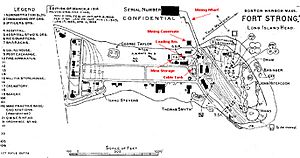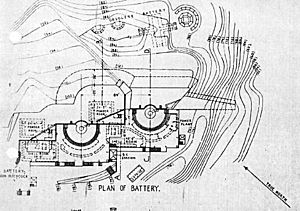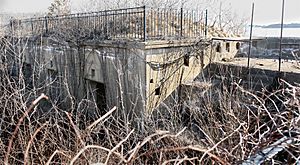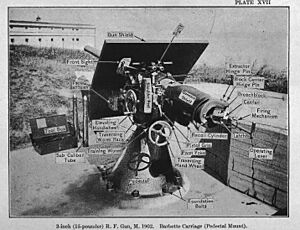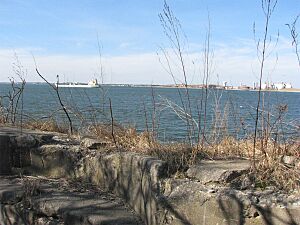Fort Strong facts for kids
Quick facts for kids Fort Strong |
|
|---|---|
| Part of Harbor Defenses of Boston | |
| Long Island, Massachusetts | |

A 10-inch disappearing gun, similar to those of Batteries Hitchcock and Ward.
|
|
|
Location in Massachusetts
|
|
| Coordinates | 42°19′47.96″N 70°57′21.53″W / 42.3299889°N 70.9559806°W |
| Type | Coastal Defense |
| Site information | |
| Owner | Massachusetts |
| Controlled by | City of Boston |
| Site history | |
| Built | 1899 |
| Built by | United States Army |
| In use | 1899-1961 |
| Battles/wars | World War I World War II Cold War |
Fort Strong was once a United States Army fort. It was built on the northern part of Long Island in Boston Harbor. The island was first used as a training camp during the American Civil War. A gun battery was added in the 1870s.
The main fort was built between 1893 and 1906. This was during a time when the U.S. was greatly improving its coastal defenses. Fort Strong was part of the Harbor Defenses of Boston. Before World War I, a large station for handling underwater mines was added. During World War II, some of its smaller guns protected minefields. The fort was later used as a Nike missile site until 1961. In recent years, it was redeveloped for a summer camp and a homeless shelter. However, the bridge to the island was taken down in 2014, stopping all activities.
Contents
How Fort Strong Began
Fort Strong's history goes back to the Civil War. A training camp called Camp Wightman was on Long Island in 1861. After the Civil War, a new battery on Long Island was named after an older Fort Strong. That older fort was from the Revolutionary War and War of 1812.
The new fort was named for Major General George Crockett Strong in 1899. Before that, it was known as the Long Island Military Reservation. From 1874 to 1876, the fort had a battery of 10 cannons. This was called the Long Island Head Battery. You can still find parts of this old battery today.
In 1893, construction began on large concrete gun batteries. This was part of a plan by the Endicott Board. They wanted to defend Boston Harbor better. Buildings for soldiers, officers, and mining operations were also built. The fort's central spot made it perfect for harbor defense. Its big guns could reach ships trying to enter Boston Harbor. Smaller guns protected the channels and minefields.
Powerful Guns of Fort Strong
Fort Strong had several important gun batteries. These were built during the Endicott period and later.
| Name | Number of Guns | Gun Type | Carriage Type | Years Used |
|---|---|---|---|---|
| Hitchcock | 3 | 10-inch gun | disappearing | 1899-1939 |
| Ward | 2 | 10-inch gun | disappearing | 1899-1939 |
| Drum | 2 | 4.72-inch Armstrong gun | pedestal | 1899-1917 |
| Basinger | 2 | 3-inch gun M1898 | masking parapet | 1906-1947 |
| Smyth | 2 | 3-inch gun M1902 | pedestal | 1906-1921 |
| Stevens | 2 | 3-inch gun M1902 | pedestal | 1906-1946 |
| Taylor | 2 | 3-inch gun M1902 | pedestal | 1906-1942 |
The Big 10-inch Guns
The main weapons at Fort Strong were its five 10-inch guns. These were mounted on special "disappearing carriages." Two guns were in Battery Ward and three in Battery Hitchcock. Construction of these batteries finished in 1899.
These powerful guns could fire shells almost 8 miles. They were meant to hit medium and large enemy ships. Electric lifts helped move ammunition and powder.
Smaller, Faster Guns
Fort Strong also had four batteries of 3-inch rapid-fire guns, with two guns each. Battery Basinger was finished in 1901. The others were ready by 1906. These guns were designed to hit faster moving targets. They also protected the minefields laid in the harbor channels.
These 3-inch guns could fire up to 6.25 miles. Batteries Stevens and Smyth faced the channel between Long Island and Hull. Battery Taylor looked toward Spectacle Island. Battery Basinger was on the northern tip of the fort, facing Fort Dawes on Deer Island.
Battery Basinger was built in a tight space near the sea wall. It had a unique underground magazine. This magazine used hand-operated chain hoists to bring ammunition to the guns.
How Many Soldiers?
Each 10-inch gun needed 43 soldiers to operate it. So, the five big guns needed 215 crew members. The four 3-inch batteries needed about 100 more soldiers. Adding in those who handled mines, searchlights, and maintenance, about 450 soldiers likely lived and worked at Fort Strong. They lived in large barracks and smaller houses around the parade ground.
Fort Strong in the World Wars
When the U.S. entered World War I in 1917, many changes happened at Fort Strong. In 1917, two 4.7-inch guns from Battery Drum were moved to Rhode Island. They were removed completely in 1919.
All three 10-inch guns from Battery Hitchcock were taken apart. The idea was to use them as railway artillery on the Western Front in Europe. One gun was sent away in 1918, but the other two were put back.
Also, a new battery of two 3-inch anti-aircraft guns was built. A third gun was added in 1935. This battery stayed active through World War II.
In 1920-1921, the 3-inch guns of Battery Basinger were removed. The 3-inch guns from Battery Smyth were moved to Battery Basinger. Battery Smyth was never used again.
By 1938-1939, all four of Fort Strong's remaining 10-inch guns were removed and scrapped. In 1942, Battery Taylor's two 3-inch guns were moved to Fort Dawes. This left only the four 3-inch guns of Batteries Basinger and Stevens, and the anti-aircraft battery, as Fort Strong's weapons.
During and after World War II, Fort Strong also hosted an Army Intelligence Service post.
After World War II
In 1945-46, a famous German rocket scientist named Wernher von Braun and six others were secretly housed at Fort Strong. This was at the Army Intelligence Service post.
In 1946, Fort Strong's last guns were scrapped. From 1952 to 1958, a radar site for the 90 mm anti-aircraft gun system was located there. In the 1950s, Fort Strong became a Nike missile launch site.
The land south of the fort was once a hospital. Today, it is managed by the Boston Public Health Commission. In 2014, the bridge to Long Island was taken down for safety reasons. This stopped all activities on the island. In 2016, a local fast food chain started an organic farm on the island.



